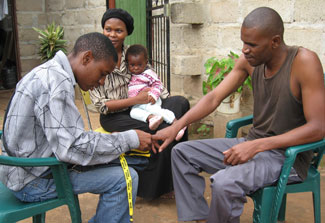South African cohort studies yield key health insights
January / February 2016 | Volume 15, Issue 1

Photo by Georges Reniers
Scientists in South Africa tackle chronic and infectious diseases to
support policymakers as they determine effective interventions.
By Cathy Kristiansen
South Africa’s population faces converging epidemics, as infectious diseases like HIV persist, while noncommunicable diseases (NCDs) and injuries become more common. NIH is supporting research in the impoverished rural region of Agincourt, where scientists hope their findings will lead to harm-reduction and prevention policies. Two of the researchers spoke recently at an NIH meeting organized by Fogarty.
“We are seeing tremendous collisions,” said Dr. Stephen Tollman, who directs a research group that has been collecting data on the Agincourt population for more than two decades. He and Dr. Kathleen Kahn are on teams conducting intervention studies based on the cohort. “Chronic infection and chronic NCDs are intersecting in mortality across the age range and also in terms of the risks,” Tollman noted. “This is a major challenge to health care systems and social development.”
Tollman’s group - the Medical Research Council/Wits Rural Public Health and Health Transitions Research Unit - is based at the University of the Witwatersrand, also known as Wits University. It includes some 30 doctoral graduates and a similar number enrolled from the region and around the world - supported by NIH and others - and is working to establish a national network of surveillance-based research. Starting in 1993, the Agincourt cohort has enrolled about 115,000 participants, who are being followed through the years, and has led to more than 500 peer-reviewed papers in the last decade.
Data across the lifespan from such a large population are a valuable research resource, Fogarty Director Dr. Roger I. Glass, noted. “This longitudinal cohort provides extraordinary opportunities to study everything from child health, to genetics, to aging, and to conduct intervention studies you cannot do in any other way.”
Myriad influences contribute to the overall health picture in Agincourt, including education levels, social environment and care systems. In one study, researchers sought to determine the main causes of death, since half the population dies at home without physician involvement. Verbal autopsies on these people showed many were killed by HIV and tuberculosis, but also prevalent were hypertension, cardiovascular disease and metabolic conditions, Tollman said. For instance, older women were as likely to have died of a stroke as HIV/AIDS. He noted among the factors fueling chronic disease are stunting during early childhood and a rising incidence of obesity in young women.
The Agincourt team continues to research infectious diseases, as well as NCDs. Access to antiretroviral therapy and other positive influences are reining in the HIV/AIDS epidemic, but new infections remain high, particularly among young women - 30 percent of whom are HIV-positive - as well as older persons.
Kahn, Tollman and their team recently studied whether offering cash payments to encourage teens to remain in high school would reduce their HIV risk. Although the study of 2,500 women did not show a lower rate of new HIV infections compared with controls, participants nonetheless reported fewer sexual partners, less unprotected sex and lower intimate partner violence, Kahn noted. The team is now investigating whether providing self-administered HIV tests for young women and their partners avoids the fear of stigma, which can discourage clinic visits. “Stigma is something that needs to be addressed,” Kahn noted. “It’s so vital to understand, because it undermines efforts to expand testing and access to care.”
Former Fogarty scientist Dr. Karen Hofman is investigating the cost-effectiveness of expanding high-impact interventions to improve health in Agincourt, for instance by reducing stillbirths and diarrheal infections in young children.
Tollman and Kahn said many social changes are underway in South Africa and studies are vital to illuminate their influence on health. These include urbanization, near universal pension income and females in the migrant workforce.
NIH’s National Institute on Aging (NIA) is contributing support to a study on how aging conditions in Agincourt affect physical and cognitive well-being over time. Other NIH funders active in the region are the National Human Genome Research Institute (NHGRI), National Institute of Mental Health (NIMH), National Institute of Allergy and Infectious Diseases (NIAID) and National Institute of Child Health and Human Development (NICHD). In addition, the NIH Common Fund supports the Human Heredity and Health in Africa (H3Africa) Initiative to advance the study of genomics on the continent.
Fogarty has supported several projects in Agincourt and now funds related training at Wits University.
More Information
To view Adobe PDF files,
download current, free accessible plug-ins from Adobe's website.